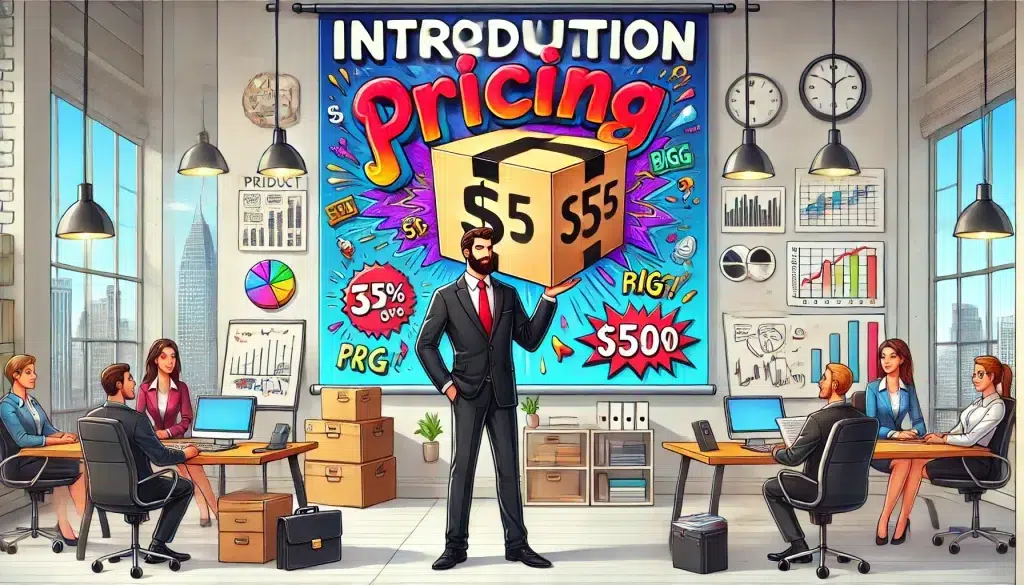
Learn how to use an introductory pricing strategy to capture a large audience quickly and effectively, setting the stage for long-term success in a competitive market.
In the highly competitive landscape of product launches, capturing a large audience quickly is crucial. One effective strategy is introductory pricing, where a new product or service is offered at a lower price initially to attract customers and build market share.
According to a 2023 report, 67% of U.S. consumers use digital coupons, demonstrating the strong appeal of discounts. This approach not only stimulates interest but also encourages early adoption, setting the stage for long-term success.
For instance, 89% of U.S. shoppers cite price as a critical factor influencing their purchases. Understanding the nuances of introductory pricing and how to implement it effectively can make a significant difference in gaining a competitive edge.
What is Introductory Pricing?
Introductory pricing is a strategy where a new product or service is launched at a lower initial price to attract customers. This tactic helps establish a market presence quickly by building a substantial customer base. Lowering the entry barrier encourages early adoption and increases brand awareness.
The approach is widely used in both physical retail and e-commerce sectors, showcasing its versatility across different industries. Once the product gains traction, businesses can leverage the initial customer base for long-term growth. The strategy also allows companies to outpace competitors who might find it challenging to match the introductory offer.
Overall, introductory pricing can effectively boost market penetration and customer loyalty.
Despite its benefits, businesses must carefully plan and monitor this strategy to ensure sustained success.
The Key Benefits of Introductory Pricing
Introductory pricing offers several key benefits that can significantly impact a product’s market entry and long-term success. By implementing this strategy, businesses can quickly attract a broad audience and foster brand loyalty.
1. Rapid Market Penetration
Introductory pricing lowers the entry barrier, making it easier for customers to try a new product or service. This approach quickly attracts a large number of customers who might be hesitant to invest in a new offering at a higher price.
As a result, businesses can swiftly capture a significant market share, establishing their presence and outpacing competitors who may struggle to match the initial low prices.
2. Increased Brand Awareness
Offering a product at a lower introductory price creates buzz and attracts attention, significantly enhancing brand visibility. Customers are more likely to talk about and share their positive experiences with affordable, high-value products.
This word-of-mouth marketing, coupled with strategic advertising, can substantially increase awareness of the new product or service, positioning the brand favorably in the market.
3. Customer Loyalty
Early adopters who benefit from the introductory pricing often develop a sense of loyalty to the brand. They appreciate the value they receive at a lower cost and are more likely to remain loyal customers as prices gradually increase.
This loyalty can translate into repeat purchases and long-term customer relationships, providing a stable revenue stream as the business continues to grow and expand its offerings.
What is the Difference Between Introductory Pricing and Penetration Pricing?
Although introductory and penetration pricing are often seen as similar, they serve different strategic purposes. Introductory pricing focuses on making a product stand out with a compelling initial price, creating a solid first impression.
This tactic typically involves a temporary low price that increases after the launch phase, aimed at generating buzz and attracting early adopters.
Penetration pricing, in contrast, is designed to establish a substantial customer base quickly by maintaining low prices for an extended period. The objective is to rapidly build market share and deter competitors by offering a price point that is challenging to beat.
This strategy is often sustained longer than introductory pricing to solidify market presence.
Real-World Applications of Introductory Pricing
This pricing strategy is extensively used in various industries, mainly retail and software as a service (SaaS). Retailers frequently launch new products with special discounts to entice first-time buyers, creating immediate interest and driving initial sales.
In the SaaS sector, free trials or significantly reduced rates for the initial subscription period are standard practices.
These offers allow users to experience the product’s benefits without a significant financial commitment, increasing the chances of converting them into long-term customers.
Moreover, e-commerce platforms often utilize introductory pricing to penetrate highly competitive markets. By offering new products at lower prices, these businesses can attract price-sensitive customers and build a loyal user base.
This strategy is also effective in generating word-of-mouth referrals, as satisfied early adopters share their positive experiences with others, further enhancing brand visibility and customer acquisition efforts.
Steps to Implement Effective Introductory Pricing
Implementing an effective introductory pricing strategy requires careful planning and execution.
Follow these steps to ensure your approach attracts a large audience and sets the stage for sustained growth.
1. Set Clear Objectives
Define what you aim to achieve with your introductory pricing strategy. Whether it’s increasing market share, building brand awareness, or generating quick revenue, having clear goals will guide your approach.
2. Research and Analyze the Market
Understand your competitors and the market landscape. Use competitor price monitoring tools, such as those provided by Pricefy, to gain insights into pricing trends and customer behavior. This data-driven approach helps in setting a competitive introductory price.
3. Define Your Pricing Thresholds
Determine the maximum price your target audience is willing to pay. Use tools like the Price Sensitivity Meter to gauge consumer price expectations and adjust your introductory pricing accordingly.
4. Develop a Comprehensive Marketing Strategy
Promote your introductory offer through various channels to maximize reach. Utilize social media, email marketing, and influencer partnerships to spread the word and attract potential customers.
5. Monitor and Adjust
Track the performance of your introductory pricing strategy. Use dynamic pricing tools to adjust prices based on market response and competitor actions. Continuous monitoring ensures you stay competitive and meet your business objectives.
The Advantages and Challenges of Introductory Pricing
Introductory pricing offers several benefits that can significantly impact a product’s market entry and growth. However, businesses must also navigate specific challenges to ensure sustained success.
The Advantages of Introductory Pricing
- Positive Customer Perception: Offering a product at a lower price initially creates a perception of enhanced value, which encourages more purchases. Customers feel they are getting a good deal, which can lead to increased satisfaction and positive word-of-mouth marketing. This positive perception can enhance brand loyalty and set a solid foundation for future sales.
- High Customer Retention: Early adopters who benefit from the initial low price are likely to remain loyal customers. They appreciate the value they receive and are more inclined to continue purchasing even when prices increase. This loyalty can result in repeat purchases and a stable revenue stream, which is crucial for long-term business growth.
- Competitive Edge: Entering the market with a lower price allows businesses to capture a significant share of the market quickly. Competitors who cannot match the low introductory prices may struggle to attract the same level of customer interest. This early advantage can establish the brand as a market leader and create barriers for new entrants.
- Increased Market Penetration: By lowering the entry barrier, businesses can attract a broader audience, including price-sensitive customers who might not have considered the product at a higher price. This expanded customer base can lead to a more substantial market presence and higher overall sales volume.
The Challenges of Introductory Pricing
- Potential Profit Loss: The initial lower prices can lead to reduced profit margins, significantly if the strategy is extended for too long. Businesses must balance the need to attract customers with maintaining profitability. Careful financial planning is required to ensure that the reduced margins during the introductory phase do not negatively impact overall business health.
- Customer Expectations: Customers who get used to lower prices may resist price increases later. This resistance can lead to dissatisfaction and potentially losing customers if they feel the new prices are too high. Businesses need to manage these expectations through clear communication and by highlighting the ongoing value and improvements in the product.
- Market Saturation: In niche markets, the impact of introductory pricing might be limited due to a smaller audience. The reduced price may not significantly boost sales if the target market is already saturated or highly specialized. Companies must assess market conditions carefully to determine if introductory pricing is a viable strategy in such scenarios.
- Short-Term Customer Focus: Introductory pricing can attract deal-seeking customers who may not be loyal in the long term. These customers might switch to competitors offering better deals once the introductory period ends. Businesses must find ways to convert these short-term customers into loyal, repeat buyers through superior product quality and excellent customer service.
Conclusion
Introductory pricing is a powerful strategy for capturing a large audience quickly and establishing a solid market presence.
By setting clear objectives, understanding the market, and using advanced tools like those from Pricefy, businesses can effectively implement and manage this strategy.
While there are challenges to consider, the benefits of increased market share, brand awareness, and customer loyalty make introductory pricing a valuable tool for any new product launch.




